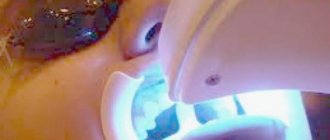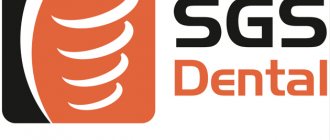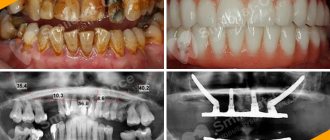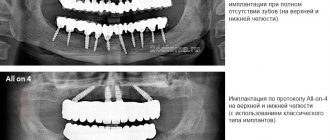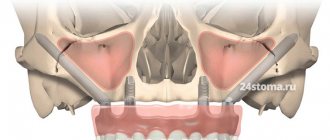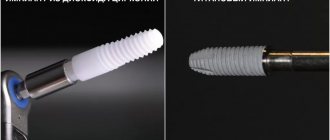Application of mini implants
Mini implants are used in certain situations. They are often used to install removable devices. Titanium pins, after they are implanted into the jaw bone, are quite stabilized. Thanks to this, they can be used immediately after surgery.
There are orthodontic mini implants that are used to correct the bite. Their use can bring teeth into proper condition.
Mini-implants are used during the preparation of the dentition for the prosthetic procedure. In the event that there is no possibility of immediate restoration of lost teeth, it is necessary that the remaining teeth do not move. Then mini implants - prostheses - are installed in their place.
Orthodontic microimplants
Miniature implants are also used in orthodontics to treat malocclusion using braces. Due to the additional support, the pressure force is adjusted based on the patient’s bite defects. They can be installed in the palate of the upper jaw, in the vestibule of the oral cavity, in the alveolar part of the jaw. The structures are temporary and are removed along with the braces. Provides increased efficiency of orthodontic treatment and reduced treatment time.
Advantages and disadvantages
There are many advantages to mini implantation. To fix a lightweight structure, mini implants for the upper and lower jaws would be a good solution.
The condition of the jaw bone tissue does not affect their installation. The operation is performed within half an hour under local anesthesia. The likelihood of injury is very low and there are no seams. Prices for mini implantation are slightly lower than for conventional dentures due to:
- small sizes;
- less equipment and time spent on surgery.
Mini implants are intended for fixation of removable dentures. In addition, they are endowed with the following advantages:
- durability;
- short period of adaptation;
- no special care required. Cleaning is performed without removing the device;
- there is no need to build up bone tissue;
- equal distribution of load when chewing;
- the presence of an orthodontic device in the mouth does not harm the remaining teeth;
- increased survival rate.
It is possible to fix removable partial dentures, bridges, crowns, clasp dentures and plastic plate structures on mini implants. With their help, the prosthesis is securely attached to the oral cavity.
Mini implants are small in size, which means they cannot completely replace real teeth. This refers to the disadvantages.
Price
- Primary appointment (examination, consultation) with a dentist (special offer) 100001
For free
Promotion
- Dental prosthetics using implants Acrylic covering prosthesis with a cast frame made of CoCr alloy (excluding the cost of fixing elements: locators, spherical abutments) 154001
60 000 ₽
- Intraosseous dental implantation of a temporary mini-implant Osstem (South Korea) 170025
9 000 ₽
- Intraosseous dental implantation of a spherical mini-implant Osstem (South Korea) 170026
14 000 ₽
Mini-implantation is the installation of small implants for comfortable use of removable dentures. Row reconstruction using classical implantation is not suitable for all patients. The method is technically complex, has contraindications and is quite expensive. As an alternative, patients are offered removable dentures, but the use of dentures is accompanied by a lot of inconvenience. To level them, they resort to mini-implantation.
Our team of doctors
Maxillofacial surgeon, Implantologist
Bocharov Maxim Viktorovich
Experience: 11 years
Orthopedist, Neuromuscular dentist
Stepanov Andrey Vasilievich
Experience: 22 years
Endodontist, Therapist
Skalet Yana Alexandrovna
Experience: 22 years
Orthopedic dentist
Tsoi Sergey Konstantinovich
Experience: 19 years
Endodontist, Therapist, Orthopedist
Varvyanskaya Anastasia Andreevna
Experience: 6 years
Dentist-orthodontist
Enikeeva Anna Stanislavovna
Experience: 3 years
Contraindications for use
Small artificial roots have certain contraindications for use. One of them is Alzheimer's disease. You cannot install such structures if you have diabetes. Neoplasms of the oral cavity of various types, including oncology.
Decompensated immunodeficiency is another contraindication for implantation surgery. Periodontal inflammatory processes. Adverse habits such as alcohol or drug addiction, as well as smoking.
Positive and negative sides
The main advantage of using the device is the possibility of using it in conditions of small volume and poor quality of bone tissue. The installation process takes no more than 30 minutes, and this is also considered a great advantage. During the implantation process, there is no danger of injuring the tissue, since the installation occurs precisely and without touching the mucous membrane.
Since the operation will not take more than half an hour, local anesthesia is sufficient. After the intervention, there are no stitches left; the upper part of the artificial tooth is installed on the same day or three days later. The use of titanium for the manufacture of the device ensures rapid survival.
The service life of the device is more than 20 years. The price of the product and installation is much lower than that of a classic device. This is due to the reduced amount of material used and quick installation without additional difficulties. The installation of implants of this type is allowed for patients of any age without restrictions.
In addition to a large number of advantages, there are also some disadvantages in application. First of all, it is worth noting that due to their small size, they are rarely used to replace units of the masticatory department. In addition, the disadvantages often include the possibility of using mini implants exclusively on the lower jaw.
When the jaw is injured, most often the structure of the type described is deformed. Despite all this, the use of smaller devices is common in dentistry and orthodontics. The orthodontic use of systems is due to the correction of bite defects through installation with braces.
Indications and contraindications
Mini dental implants are indicated if:
- atrophy of the alveolar processes of the bones and tissues of the jaw;
- contraindications to conventional implantation;
- inconvenience of wearing removable devices;
- complete absence of teeth.
The condition of the bone tissue is not of primary importance in the indications for this implantation, so there are a small number of contraindications. These include the presence of:
- malignant tumors;
- diabetes;
- addiction – alcohol, drugs, tobacco.
- diseases for which all surgical interventions are prohibited.
Mini-implants for fixing removable dentures
The upper part of mini-implants (abutment) has the shape of a ball. A metal base with a rubber ring fitted to it is installed in the prosthesis. The design is fixed by snapping when the ball hits the hole. The rubber seal eliminates the vertical movement of the prosthesis and prevents discomfort while eating or talking. A prosthesis fixed in this way on mini-implants cannot fall out.
Construction installation technology
The procedure begins with determining the location where the pins will be installed, as well as their number. The distance at which they should be ranges from 5 to 8 mm.
Then the doctor administers local anesthesia and begins piercing the gums. The implant is screwed into the bone using the self-tapping method. After the implant is fixed in the bone, a removable denture can be used.
Special locks are attached to it, thanks to which they are firmly held on the mini implants. In order for a removable denture on the lower jaw to be comfortably used, four pins are enough. They are placed on the front. This decision is influenced by the fact that the bone in this place is stronger. In case of proper and careful care of the device and the oral cavity, the prognosis for wearing it is very favorable.
The number of pins in the upper jaw reaches up to six, since in this place the bone is loose and the maxillary sinuses are located nearby. After surgery, you should only eat soft foods. When pain occurs, painkillers are prescribed.
Author:
Features of prosthetics on the lower and upper jaw
For full jaw prosthetics, a minimum of 4 mini-implants are required. The degree of fixation of this design corresponds to a prosthesis on two full-fledged artificial roots. But the stability is higher, because 4 micro-roots are distributed throughout the jaw, and the classic ones are installed only in the frontal zone, so the structure will be balanced.
The designs differ from traditional removable dentures:
- The shape of the upper jaw prosthesis with mini implants is smaller, without an artificial palate. Diction is not impaired, taste perception does not deteriorate.
- When lower jaw prosthetics do not require the use of special gels to improve fixation.
Recovery after surgery
Judging by patient reviews, recovery after installation of mini-implants occurs quite quickly. This is facilitated by the small size of such structures and their minimally invasive installation. However, implantologists still recommend that most people take antibiotics and antihistamines to speed up rehabilitation. It should be remembered that, despite minor tissue trauma, the operation was still performed. And in order to avoid complications [1] (mobility and displacement of implants), the load on the installed prostheses should be temporarily limited.
What are the disadvantages
The limitation for installing mini-implants is the impossibility of fixing permanent dentures, since miniature structures are not suitable for heavy loads - they cannot be used to fix single crowns or dental bridges designed for both part and all teeth at once.
Disadvantages also include the loosening of mini-systems in the bone, which occurs during the first 3 years of their operation. There is only one way out - to remove them and install models of standard sizes. Another disadvantage is the rapid wear of spherical abutments, and given that almost all mini-implants are solid and the abutment cannot be replaced, the prosthesis will increasingly shift and wobble under load.
Patient reviews
Irina, 36 years old
I gave birth, and my teeth began to decay catastrophically. As a result, the orthodontist offered me mini implantation. Standard implants would have cost me a lot more. Within an hour, I “grew” gorgeous, strong teeth.
Nikolay, 52 years old
My entire lower row of teeth gradually collapsed. The removable jaw left a terrible impression; it kept falling out. After installing microimplants, I simply began to live fully. The implants took root completely and nothing hurt. I wish I had installed them sooner.
Katerina Stepanovna, 66 years old
I’m not young anymore, and I don’t have many teeth. The doctor suggested mini-implantation to me because my jaws are weak and full-fledged implantation is contraindicated for me. I had 5 artificial teeth installed, everything went well, they all settled in perfectly.
Evgenia Vasilievna, 50 years old
The lack of teeth almost drove me to suicide. I couldn't use the artificial jaw because it was wobbly and my speech was slurred. I was generally afraid to chew, as the pain was terrible. The appearance of microprostheses in my life changed everything. This is a way out for people like me.
Based on many positive reviews from patients, we can judge mini-implants as a very successful invention of orthodontists that can help quickly restore lost teeth. And the affordable price of mini-designs allows even people with little income to fill their mouths with teeth.
Sources used:
- Lee, S. L. (2007). Applications of orthodontic mini implants. Hanover Park, IL: Quintessence Publishing Co, Inc.
- Chen, Y.; Kyung, H. M.; Zhao, W. T.; Yu, W. J. (2009). "Critical factors for the success of orthodontic mini-implants: A systematic review." American Journal of Orthodontics and Dentofacial Orthopedics.
- Ibragimov T. I., Bychkov A. I., Aleshin N. A., Tibilov V. F. Use of a new type of superstructure with a microshock absorber on dental implants in prosthetic treatment of patients with complete absence of teeth
How long will mini implants last?
Many patients are interested in how high quality mini-implants are and how well they withstand loads? Most manufacturers claim that miniature systems have a service life of at least 10 years. But this is under ideal conditions, for example, when the bone is dense enough, the installation took place without complications, and the patient follows all the recommendations for wearing (in other words, limiting himself to solid food) the prosthesis and caring for it. Typically, the service life rarely exceeds 3-5 years - after this, the systems must be removed, and the patient requires the installation of implants of standard sizes.
Free consultation
Our specialists will conduct a free consultation and select the best treatment option for you.
Sign up now! Online registration
+7 (495) 649-41-19
Installation on ball adapters
This is a classic fastening option that has been successfully used for about 10 years. Such adapters are made of metal material and resemble small balls protruding beyond the mucous membrane.
It should be noted that a recess is created on the inside of the prosthetic device, which is necessary for fixing the holder and the silicone matrix. When fixing this design, the matrix helps to securely hold the ball-shaped adapter in the neck area.
Specifics of installation using the LOCATOR system
This is one of the most modern methods of fixing removable orthopedic structures. It is characterized by increased comfort for the patient. In this case, transition elements of the equatorial type are used, which have a specific shape. The diameter of such implants can reach 2.5-4.0 mm.
Also, the advantages of the LOCATOR system include: ease of fixation and removal of the prosthesis, no need for frequent visits to a specialist, and the possibility of use when the axes of dental structures do not correspond to each other. Moreover, in the case of using equator-type adapters, the likelihood of their wear and the need for replacement is eliminated.
Rehabilitation period
Mini-implantation is a minimally invasive procedure, so recovery is easy and without much discomfort. After a week, all the unpleasant sensations go away. In case of individual predisposition, slight swelling is possible. For such a case, our Center provides a complex of accelerated rehabilitation. Prevents facial swelling and relieves pain.
Getting used to dentures with mini-implants is much easier and faster than with conventional removable ones - adaptation takes only 2-3 days due to the reduced size of the base.
General overview
From a technical point of view, a mini-implant is a structure implanted into tissue using a transgingival technique, replacing the lost root part of a tooth, and allowing the load of the prosthesis in the early stages of integration. Visually, the system is similar to a screw on which a titanium abutment is located, which serves as the basis for an artificial crown.
